There is over $150 billion worth of crypto staked on various networks around the globe. That figure is reflective of a story: staking is no longer an eccentric experimentation, just like the beginning, but it has emerged as one of the most widespread methods of gaining yield in the digital asset industry.
To the majority, the attraction is even higher when it is tokens that are already trading below a dollar. They are perceived to be accessible, affordable, and, at least psychologically, offer the prospect of greater upside. That’s why staking altcoins under $1 has captured so much attention.
This is not a race to run after high APYs, though. Blockchains such as Cardano, Algorand, Hedera, VeChain, and The Graph apply staking to validate their network, but in exchange, offer rewards to their users. But when it is correctly done, it becomes an on-ramp to draw interest in crypto as well as ecosystem development. When not done right, it can turn into a course in volatility, liquidity lock-ups, or smart contract risks.
This guide will help sift through the hype and get to the truth of what staking is, why cheap altcoins are interesting, where the real opportunity is, and how to distinguish between actual projects and speculative hype.
⚠️ Disclaimer: This article is for educational purposes only and should not be considered financial advice. Always do your own research before making investment decisions.
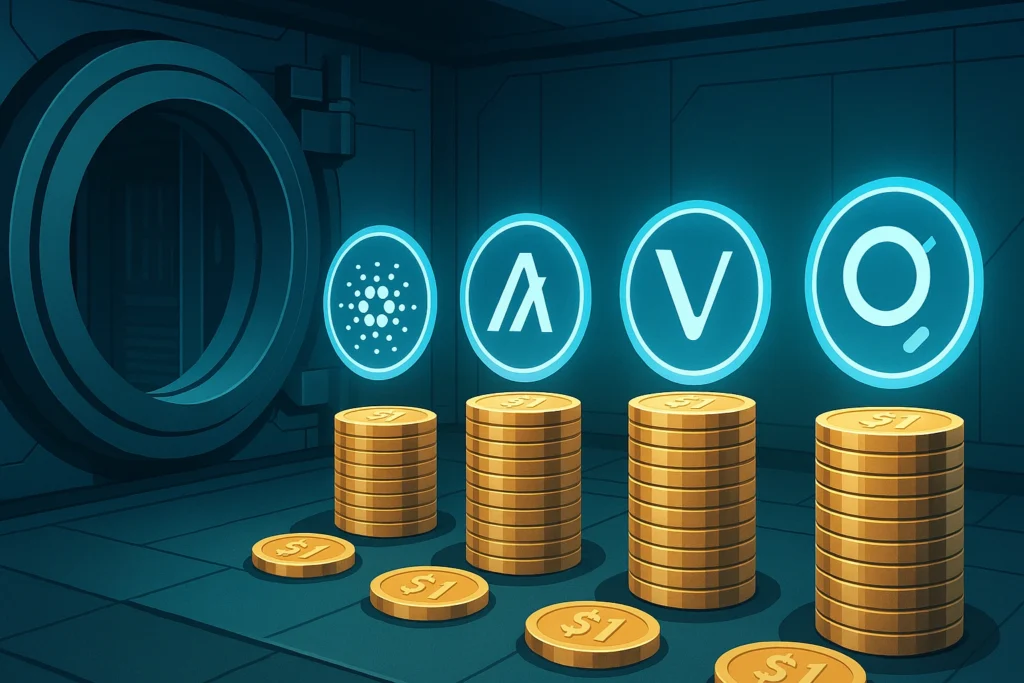
Methodology: How We Chose These Altcoins
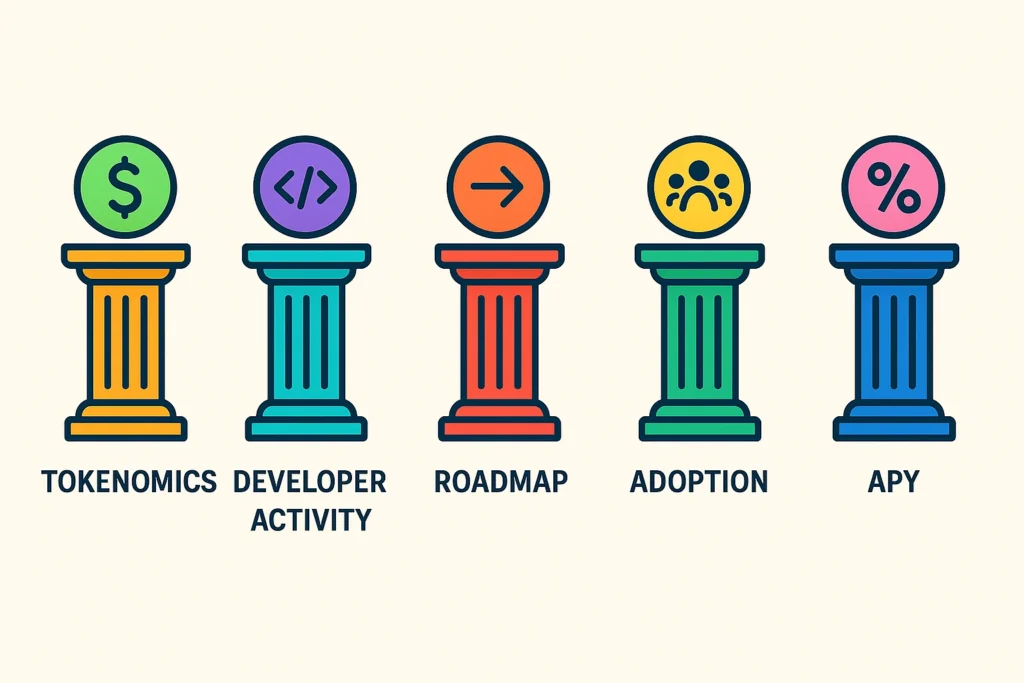
Whenever you start out with a list of the so-called best coins, the first thing to ask is why these, as opposed to the hundreds more? We did not want our selection to be random or driven by hype. Ok, this is the playbook that we used to eliminate it.
The first interesting filter, which is easy to guess, is that the coin must be trading within one dollar as of August 2025. That served to restrict the concentration on those tokens that would support our theme and that of the search intent.
Then we considered the question of whether each of these projects has real staking or yield opportunities. There are coins with excellent technology and no method to get interest currently- they did not make the list.
We then verified reward rates (APYs) using sources we trust, such as StakingRewards, Messari, or official project documents. Anything that sounded either wild or was a dubious source was excluded.
Developer activity and ecosystem adoption were also key factors. A coin may promise 50% APY on paper, but when the team has become silent on GitHub or there is no actual traction in the world, then that payoff will hold little weight.
AND, of course, we were seeking a creamy combination: two or three names that have a good track record of success, and some newcomers that could give us a surprise. In such a way, the list remains stable and innovative.
By spelling this out, we are indicating the following: this is not financial advice, and it is not a get-rich-quick list. It is a clear, research-guided examination of staking altcoins under $1.
What Is Staking in Crypto?
Staking is, at its most fundamental form, a way of using your crypto to assist in maintaining and securing a blockchain network. Rather than costly mining hardware, with proof-of-stake chains, token holders use their tokens to facilitate transactions when it is time to lock up their tokens. They, in turn, get rewarded within the network-it can be seen as earning interest (of the altcoin) and helping fuel the network.
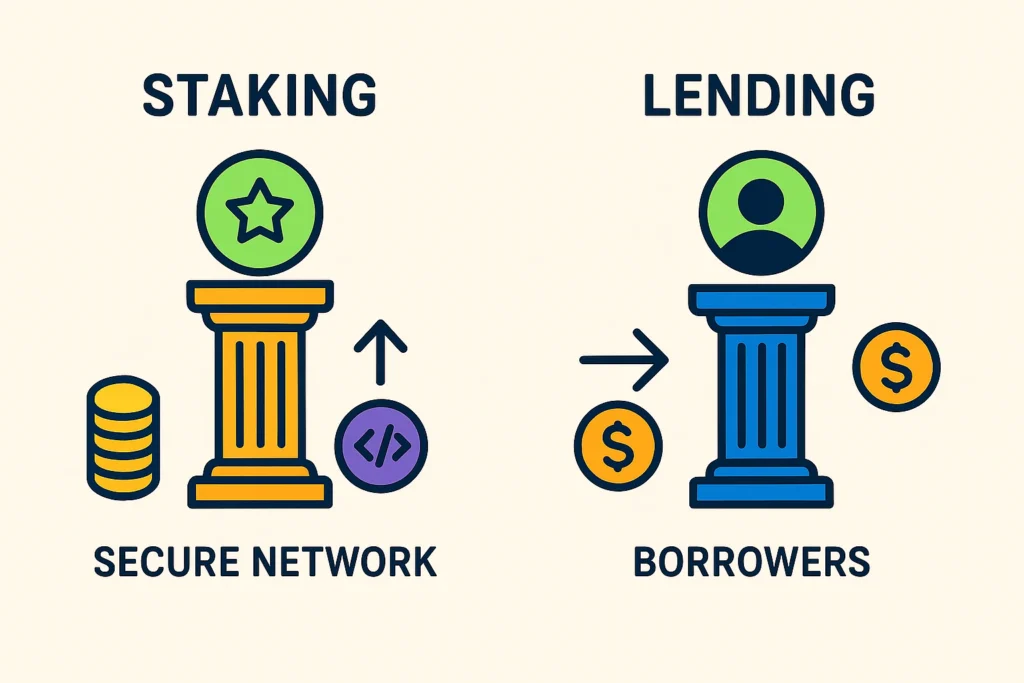 It is handy to make a comparison of staking with lending because the two are frequently confused. By lending your tokens, you are giving them to a third party that loans out your tokens or puts them into liquidity pools. Staking is not the same: your coins are used in the consensus mechanism of the blockchain itself, and you are a solid part of the body.
It is handy to make a comparison of staking with lending because the two are frequently confused. By lending your tokens, you are giving them to a third party that loans out your tokens or puts them into liquidity pools. Staking is not the same: your coins are used in the consensus mechanism of the blockchain itself, and you are a solid part of the body.
The following is but a rudimentary one. Staking 1,000 Cardano (ADA) with a staking pool could generate about 4-6% with about 40-60 ADA per annum. The figures will fluctuate due to pool performance and network congestion, but indicate how staking can yield a sustainable income without your having to trade every day.
Naturally, staking is not riskless. Not all of these networks are lock-up, however. This means you can not instantly sell your tokens in case prices fall. Volatility also may erase the rewards-a 10% yield is meaningless when the token drops 50%. And when it comes to DeFi staking, there is a danger of smart contract bugs or hacks that threaten finances.
Properly done, however, staking can be a means of helping sustain blockchain economies and can be a passive means of earnings as well.
Why Consider Staking Altcoins Under $1?
The attractiveness of low-priced tokens is based on the psychology of many investors. When such a coin is worth below a dollar, thousands of units of the coin feel more rewarding than a part of Bitcoin or Ethereum. Although price is not the only determinant of value, such affordability is what attracts new entrants into the staking ecosystem.
Staking altcoins under $1 can look attractive because they often promise
than larger “blue-chip” tokens like ETH or SOL. Smaller projects can offer higher APYs of up to %digits, enticing early adopters and network participants.
A real-life analogy will be as follows:
- VeChain (VET) currently offers up to ~9.1% APY in certain staking tiers through programs like StarGate.
- In contrast, Cardano (ADA), a well-known sub-$1 altcoin, provides staking returns in the ~3–5% APY range.
This difference may not be that significant, but upon compounding, the effect can have a great impact as far as portfolio growth is concerned. For example:
- Staking $1,000 in VeChain at 9% APY yields around $90 a year.
- The same in Cardano at 4% nets just $40.
However, there emerges the need to provide a reasonable balance between risk and reward. A more volatile or illiquid 9% offering is also possible, and with under-$1 altcoins, there is generally a smaller market cap attached to it, so your gains may be quickly whittled away when the coin price falls 30 40%. Furthermore, not all staking options may be limitless; some of them could combine a lock-up or have technical complexity.
The long and the short of it is simply that sub-dollar altcoins are potentially rewarding, but historically, most sub-dollar coins have struggled to sustain long-term value. It is a niche that can provide yield, particularly to people who are ready to do some research work, as well as potentially achieve diversification away from the highest-quality tokens.
The 5 Best Altcoins Under $1 for Staking in 2025
Coin staking is not the same. Some promise absolute sky-high gain but then die off in silence, and then there are those that settle down and spread by gradual assimilation and modest, relatively consistent returns. Following a long scouting of purposes, these are five altcoins priced under a dollar that stand out in 2025. They both have a working staking system, audited statistics, and a community keeping them energized.
Cardano (ADA): The Reliable Staker
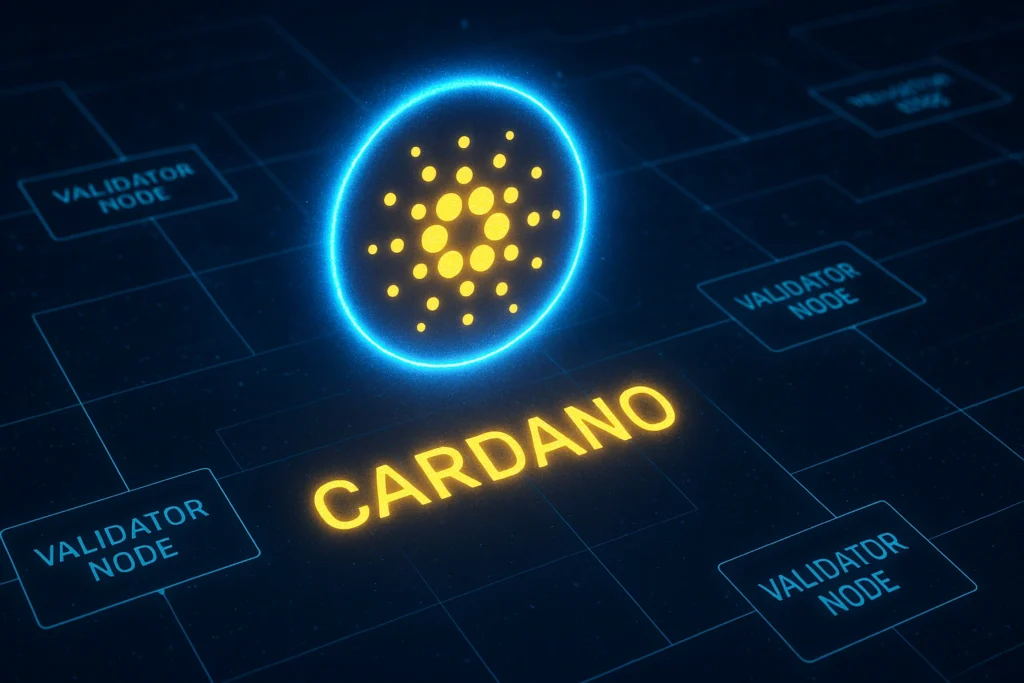
- Background
Co-founded by Ethereum veterans and lead designer Jeremy Wood, Cardano was introduced in 2017. It is a PoS blockchain anchored by the Ouroboros blockchain protocol, mathematically proven to be secure academically -probably the first PoS blockchain protocol to achieve formal security proofs in 2013. This project is divided into three groups: IOHK, EMURGO, and the Cardano Foundation; each of them focusing on development, commercialisation, and ecosystem development, respectively.
- August 2025 Live Price
As of August 18, 2025, Cardano (ADA), is found at about $0.91, which is firmly inside our under $1 decision.
- Tokenomics
ADA has a fixed supply of 45 billion units, of which about 35.7 billion are in circulation. It implies that more than 79% of the supply is already in circulation. Unlike a lock-up mechanism, the protocol can promote staking through delegation, and hence decentralization and long-term security.
- Developer Activity
Cardano is very active on GitHub. A recent report by Santiment showed ADA is among the 5 top crypto projects with developer activity, above most of its competitors. The next fact indicates that Cardano is ranked 2nd in the overall number of commits year to date, with greater than 150,000 commits made to the entire Cardano ecosystem, and an overall view of more than 12,000 developers involved in working on core and side projects. These figures indicate a gravely advanced blockchain on a steadily increasing scale.
- Ecosystem Adoption
At Q2 2025, the Cardano Foundation has increased in developer programs (such as Aiken smart contract tooling), but also promoted real-world adoption through identity and traceability solutions (such as Veridian identity system, Originate for wine provenance). Such undertakings demonstrate that Cardano is headed toward practice and away from theory.
- Staking Specifics
Where to stake: ADA stakers can easily stake by delegating in wallets such as Daedalus (full node) or Yoroi (lightweight), which are non-custodial and user-friendly.
APY: Real-world returns are near 2.5-3% APY, depending on the health of the pool; platforms such as Everstake are reporting ~3% APR, and others, such as YouHodler, offer up to 7% APY, which is provider and not protocol-based.
Risks: No lock-up (you may leave epoch (~5 days) later); the delegation pool health and network parameters change may affect performance.
- Balanced Verdict
Cardano is amongst the most popular pools to stake and presents modest returns. Its history of uptime and consistent development makes it attractive to more risk-averse stakers. But as it has a less ambitious roadmap than new projects and a lower APY, the opportunity is also lower.
Algorand (ALGO): Staking Made Clean, Quick, and Accessible
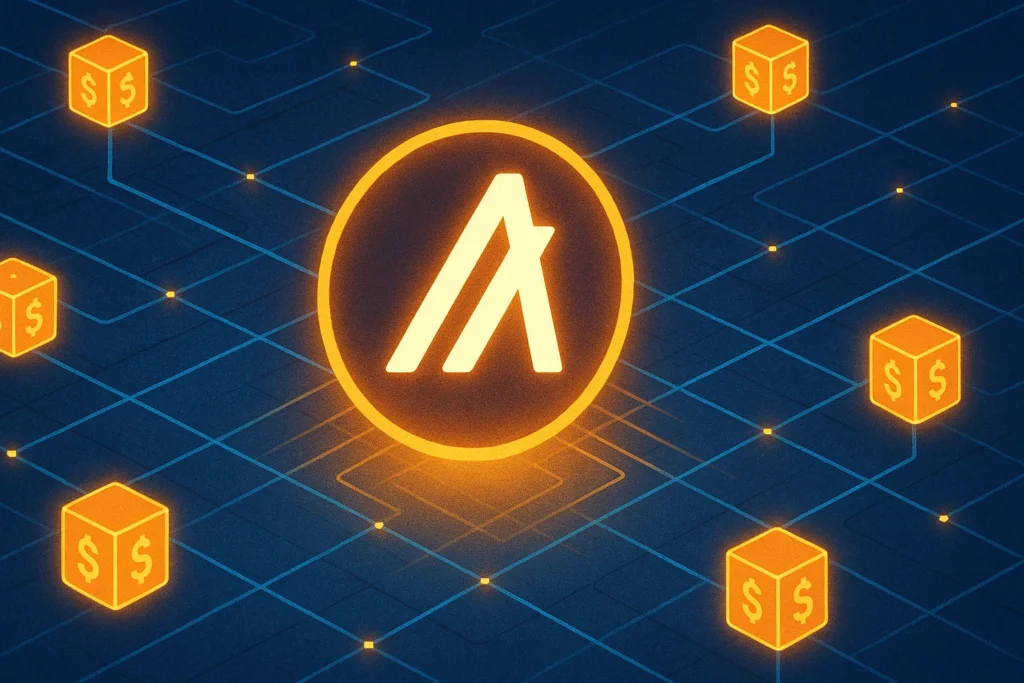
- Background
Algorand was conceived in 2017 by Silvio Micali, a cryptographer at MIT, and created a pure proof-of-stake (PPoS) scalable blockchain with low fees and decentralization. Unlike similar chains, even everyday individuals holding ALGO in their wallets contribute to network security–there are no expensive hardware requirements.
- August 2025 Live Price
ALGO is currently trading around (18th August, 2025) the range of $0.26, comfortably below our $1 mark.
- Tokenomics
There is a total supply limit of 10 billion coins of ALGO, and about 8.7 billion (87%) of them are in circulation. The balance has already vested. Importantly, participation rewards are allocated in advance out of the current supply- they are not inflationary, but the overall emission rate decreases over time.
- Ecosystem Growth and Developer Activity
In 2025, Algorand has been racing ahead, with new developer tools such as AlgoKit 3.0, which added TypeScript and visual debugging support, and the Algorand 4.0 upgrade soon rolled out real-time staking, faster block times, as well as quantum-resistant capabilities. Such upgrades resulted in the growth of mainnet nodes by 179% and an increase in new asset issuance by 52% as early as March.
- Staking Specifics
| Feature | Details |
| Where to stake | Run a node (minimum 30,000 ALGO) or join via liquid staking & pools like Pera, Folks Finance, Tinyman, no slashing, no lock-up. We noticed community forums often report smoother experiences with Algorand’s Pera wallet compared to third-party staking apps |
| APY | Protocol-level yields started around 6–7% at launch, but fluctuate based on network activity. Lower-tier rewards exist for voting and governance. |
| Risks | Annual yield varies. Daily returns can spike or drop based on block proposals. Running a node needs moderate hardware. |
- Balanced Verdict
A user-friendly staking process and eco-friendly status have made Algorand gain a favourable fan base. The process of staking that is done using the Pera wallet can even be termed as smoother than when it was done by third-party applications, and this is in addition to the usability of the tool. Nevertheless, the volatility of the price of the coin and the drop of the market capitalization during the last years demonstrate the risks of overexposure.
The Graph (GRT): Powering Web3 Data With Delegated Staking
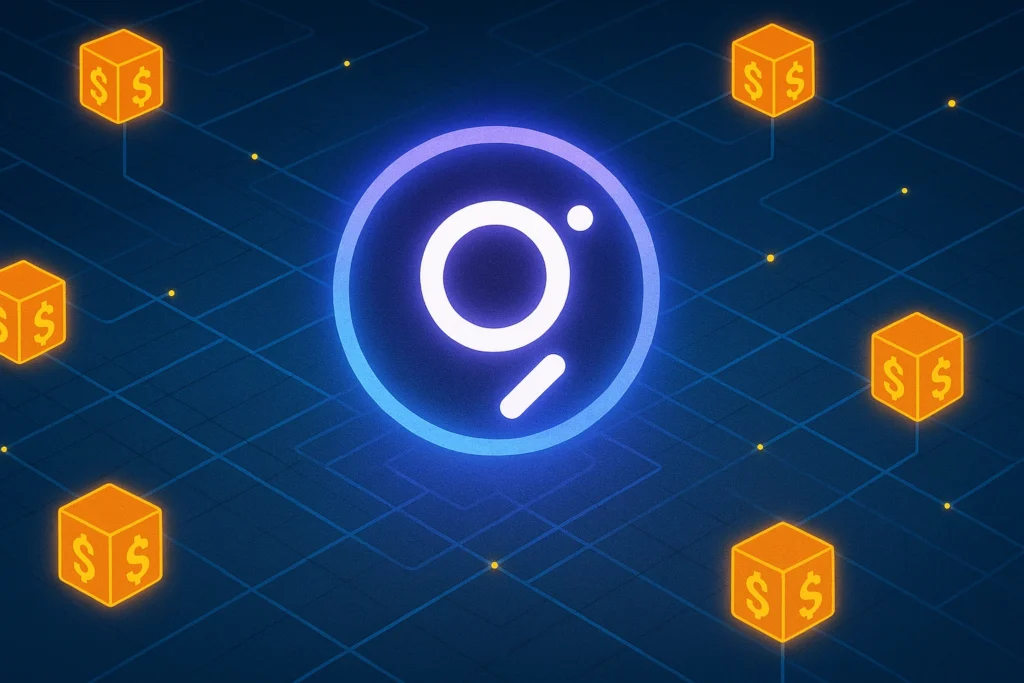
- Background
The Graph is the so-called Google of blockchain, which was created in 2020. Rather than websites, it indexes blockchain data and makes it available to decentralized apps (dapps). It runs on the GRT token that rewards indexers, curators, and delegators.
- Live August 2025 Price
On 18th August, GRT is hovering at about $0.09, so it is still well under the $1 mark.
- Tokenomics
- Total supply:8 billion GRT.
- Circulating supply: ~10.4 billion
- There is a modest inflation rate (~3 percent per annum), and staking rewards are paid in newly minted GRT and dapp query fees.
- Ecosystem and Growth of Ecosystems Developer
The Graph is among the most active Web3 infrastructure projects. In 2025, the team released the indexing on Substreams, faster querying of real-time blockchain data made available by dapps. It is among the most popular developer commits in the infrastructure projects on GitHub in the leading tier. Its subgraphs are used in networks, such as Ethereum, Arbitrum, and Polygon.
- Staking Specifics
| Feature | Details |
| Where to stake | Delegators stake via the Graph Explorer, selecting an indexer. You don’t run hardware yourself. |
| APY | Returns are variable, typically 6-10%, depending on indexer fees and query demand. StakingRewards lists current rates. |
| Risks | There’s a 0.5% delegation tax (burn) when you stake. Unstaking involves a 28-day unbonding period. If you pick a poorly performing indexer, returns can lag. |
- Balanced Verdict
The Graph is the focal point behind the Web3 infrastructure, and the staking of GRT sustains a network that drives the blockchain indexing and data. Rewards may be competitive, particularly in delegated staking. But the project is yet to reach full maturity, and rewards can be variable as tokenomics changes. It is a long-term promising network, yet with a short-term doubt.
Hedera (HBAR): Enterprise-Grade Staking, Low Yield
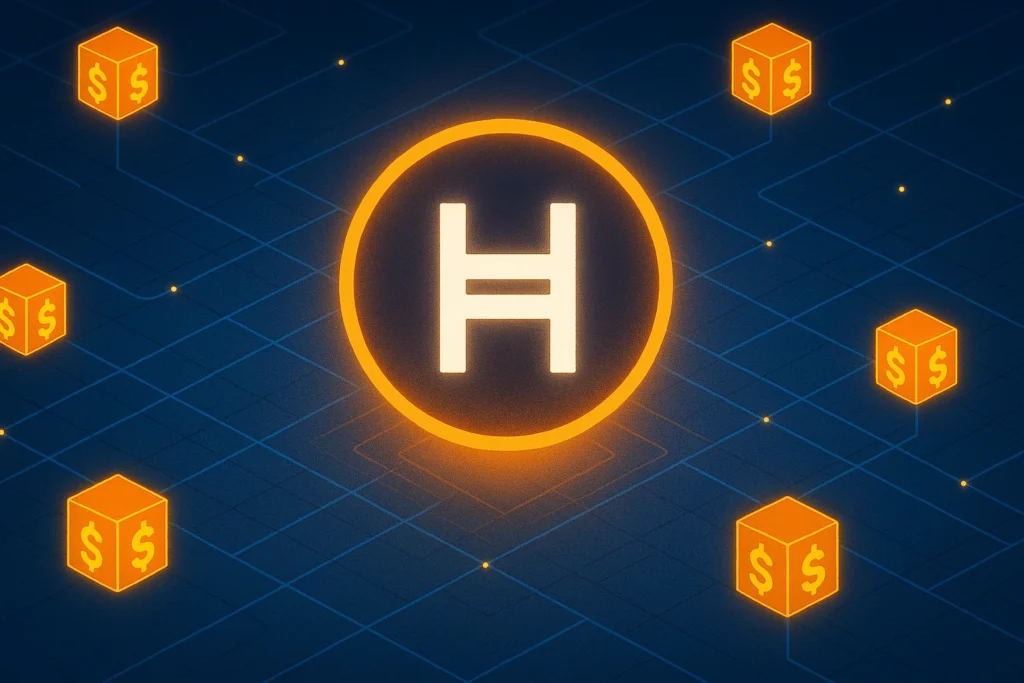
- Background
Hedera is not based on a blockchain but on a special hashgraph consensus. The governance of it is dealt with by the Governing Council that features blue-chip players such as Google, IBM, Boeing, and LG, which is an odd combination in the crypto arena. Serious enterprise is the credibility of that structure.
- August 2025 Live Price
As of this writing on 18th August, HBAR is at about the $0.25 mark, comfortably below our $1 mark to be in this list.
- Tokenomics
The total token supply of HBAR is 50 billion, with over 42 billion tokens already circulating. There has been robust volatility in the price, and institutional demand/ecosystem expansion has induced investor attention.
- Ecosystem Adoption & Developer Activity
- Hedera is riding the enterprise adoption wave-SCB TechX, Shinhan Bank, and others have run trials with tokenized remittance.
- The network can also be described as carbon-negative, which falls in line with ESG requirements, a hot spot of interest among institutional capital.
- Tooling towards developers is also getting better: EVM tool support (Hardhat, Foundry), more capable mirror-node debugging, and contract diagnostics are currently available or in progress.
- Staking Specifics
| Feature | Details |
| Where to Stake | HBAR staking is built into the network. You associate your balance to a node (supported by wallets like HashPack or Ledger). Hedera’s staking docs walk you through the simple process. |
| APY (Yield) | Maximum native staking rewards are capped at ~2.5%, but real-world rewards are currently much lower, often under 0.1%, depending on network revenue and total staked supply. Communities on Reddit report seeing returns closer to 0.01%. |
| Risks & Conditions | Rewards are dynamic and can shrink if too many tokens are staked (over 13% of supply). No lock-ups, though the yield may be negligible depending on network conditions. |
- Balanced Verdict
Hedera is unique with its council of world companies in its governance, which brings in institutional trust. It has a user-friendly staking model whose development has been driven by consistent ecosystem growth. Critics nevertheless tend to show attention to a semi-centralist aspect of governance, which may not be well aligned with positive views of decentralization purists. To stakers, this is the balance between innovation and safety.
VeChain (VET): Real-World Utility Meets Adaptive Staking
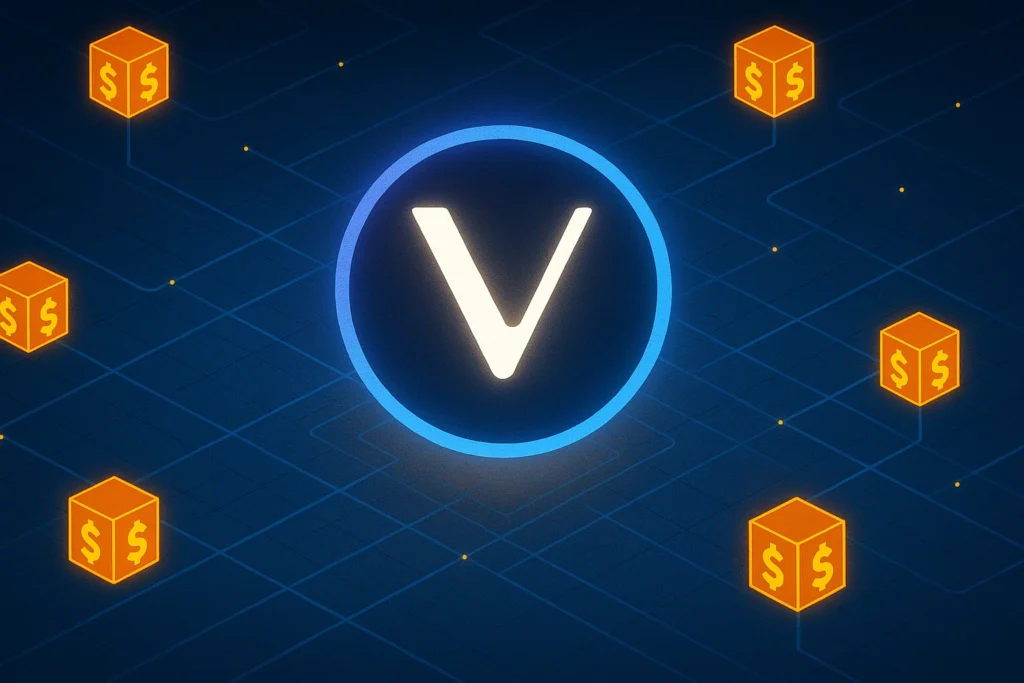
- Background
VeChain was founded in 2015 and is being led by Sunny Lu (ex Louis Vuitton China). In contrast to other blockchains, VeChainThor is built on proof-of-authority (PoA) consensus, so vetted authority nodes will verify transactions. It is the most famous entity in terms of enterprise relationships–keen on PwC, BMW, Microsoft, etc., and in-life supply chain integrations.
- Live August 2025 price
VET trades between $0.02 and $0.03 today(18.08.2025), soundly below the mark of $1 we envisage.
- Tokenomics
VeChain has a dual token structure, meaning that there is a token of value transfer, VET, and transaction gas, VTHO. The overall supply is limited to approximately 86 billion VET, and the greater part of the assets is circulating. By the end of 2024, the circulating quota is above 99%.
- Ecosystem Adoption Developer Activity
Due to deep anchors in the enterprise use cases, VeChain empowers such applications as product traceability and carbon tracking. Its customer base is comprised of PwC, Renault, and the UFC, which demonstrates that this takes place in the real world rather than being hyped.
- Renaissance Update – Staking Specifics
In June 2025, VeChain began the era of a new staking game with the arrival of the VeChain Renaissance upgrade. Staking will now be modelled through Economic Nodes and X-Nodes, which both produce Delegator Staking NFTs. Then these NFTs are delegated to Validators to earn VTHO rewards at weighted tiers.
VeChain-occurring websites such as VeChainStats peg staking APYs between 1.5 to 7.7% based on your node tier and the size of your stake.
According to an early adopter’s view on Reddit:
Delegators will now require 70% fewer VET to earn equivalent rewards thanks to tiered X-Nodes.
Here’s how node tiers stack up:
- MjolnirX: ~15,600 k VET, reward weight 5.0
- VeThorX: ~600 k VET, reward weight 2.0Each tier caps how many nodes of that type exist, balancing rewards and scarcity
- Balanced Verdict
The company boasts of a special dual-token system and business alliances; this aspect makes VeChain credible among the blockchain-based business proponents. Its staking returns are competitive below $1, but it is yet to be widely adopted beyond supply chain applications. VET matters to users who appreciate the utility-oriented networks, but struggles to spread its wings.
Where to Stake Altcoins Under $1
Ever wonder where all that staking reward money comes from? The answer is what you parked them in. There are individuals who can use the convenience of the plug-and-play of large exchanges, others are loyal to their native wallet, and the risky few can immerse themselves in the world of DeFi. Let’s walk through the landscape of platforms for staking altcoins under $1, and see what makes each path appealing, or risky.
Centralized Exchanges
Centralized exchanges are difficult to beat as far as you want the process of staking to feel painless. Exchanges such as Binance, Coinbase, and Kraken allow you simply to stake ADA or ALGO with a few clicks.
The obvious advantage is that you do not have to go through the process of maintaining validator nodes or concern yourself with upgrades to the network. All is done in the background. The trade-off is control. After staking your coins on an exchange, the coins are in custody, not yours. To some, it is worth the risk. Others just don’t have to be reminded that it is not your keys, it is not your coins, so keep away.
Native Wallets
Native wallets are a simple alternative to those of us who would prefer to maintain ownership of our crypto. You can delegate directly with Cardano through the Daedalus full-node wallet or the lightweight Yoroi option. Algorand’s own sleek tool is the Pera Wallet, where voting and governance are executed.
The benefit in this is obvious: this is self-custody- you have custody of the private keys, you take the rewards, and you do not need anyone to trust. The catch? It takes a little more responsibility. You will also have to preserve your wallet and, at times, remain updated on the network changes.
DeFi Protocols
Then there is the outskirts of staking: decentralized finance. Such protocols as Lido and Tonstakers set an additional twist. Not only do you get rewards when you stake through them, but you also get a liquid staking token in exchange. That token may be used elsewhere in DeFi, in lending markets or liquidity pools.
It is the have your cake and eat it too form of staking, but there are risks involved. DeFi is not foreign to exploits, and smart contracts can malfunction. The flexibility can be highly attractive, though, provided you feel comfortable maneuvering through those risks. Otherwise, a wallet or exchange will seem safer.
Quick Comparison: Staking Altcoins Under $1
| Coin | Live Price (Aug 2025) | Where to Stake | Typical APY | Pros | Cons |
| Cardano (ADA) | ~$0.91 | Daedalus, Yoroi, Binance etc. | 3–7% | Trusted PoS, non-custodial, wide support | Yields are moderate, vary by pool |
| Algorand (ALGO) | ~$0.26 | Pera Wallet, Binance etc. | 1–10% | Fast, eco-friendly, governance incentives | Returns highly variable, platform-dependent |
| The Graph (GRT) | ~$0.09 | Graph Explorer, DeFi platforms | 5–17% | Web3 data layer, high-yield potential | Fees & unbonding, platform variation |
| Hedera (HBAR) | ~$0.25 | HashPack, Ledger, others | <1% (native); up to 5–6% via platforms | Enterprise-backed, governed, carbon-negative | Low yield, volatile, platform-dependent |
| VeChain (VET) | ~$0.03 | StarGate, VeChainStats, Binance | 1.5–8% | Real-world utility, staking upgrade model | Complex tiers, variable returns |
Risks of Staking Altcoins Under $1
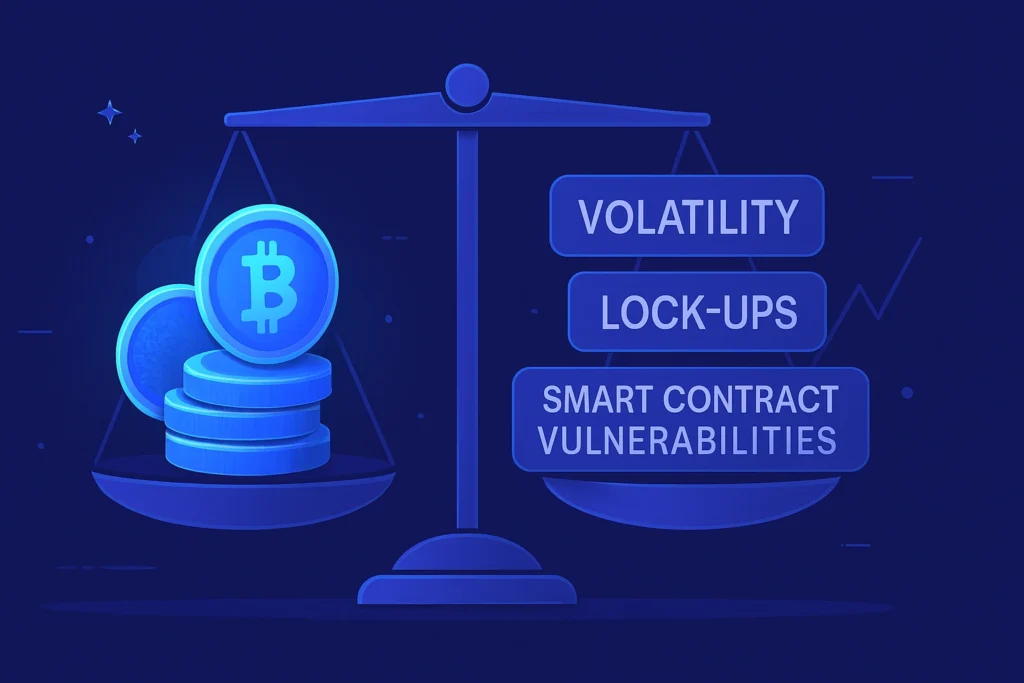
Staking may sound like a dream passive income strategy: lock your coins, gain interest, and make them grow. However, things do not always look that straightforward when we are talking about altcoins that are valued below one dollar. It is always advisable to calculate the risks involved in the possible rewards before taking the plunge.
Volatility
Most of the low-priced coins tend to move. A penny stock that trades below a dollar can move 20 to 30 percent in one week. This implies that just as you are making 5 percent interest annually, prices could be slashed, destroying those earnings within a few hours. Unlike blue-chip tokens, smaller caps cannot absorb shocks with the help of robust liquidity cushions. We witnessed that in the case of Terra (LUNA) in 2022, once a leading staking coin, it got close to zero when its algorithmic stablecoin collapsed. It is a reminder of the fact that the staking rewards are irrelevant if the underlying token loses the majority of its value.
Liquidity Lockups
A lot of staking programs have a lockup period where you cannot withdraw tokens, so for some of them it might be days, and for others it might be months. When that period comes, you cannot sell your coins or relocate them. Should the market go down, you are at its mercy. Social sites such as Lido have attempted to address this using liquid staking tokens, but they possess their complications and dangers. The failure of Celsius Network is a warning: deposits of many users were stuck in an account yield in the middle of 2022 due to the suspension of withdrawals by the collapsed platform, and massive losses occurred.
Custodial/Self-Custody Risks
Staking on centralized exchanges such as Coinbase or Binance It is simple to do, but it involves entrusting possession of your property. Like we say: not your keys, not your coins. Meanwhile, on the one hand, there is self-custody through native wallets such as Daedalus or Pera Wallet leaves much control in your hands–it also completely puts you in charge of security. Misplace the keys and you can not call a help desk.
Smart Contract Weaknesses
There is one great caveat of DeFi staking: code risk. Such protocols as Tonstakers and others support smart contracts to automate rewards. When that code is faulty or even misused, money can disappear in a matter of seconds. Audits can also help mitigate the risk, but can never eradicate the possibility of a risk.
Industry Case Study: Solana Downtime
Staking risk was featured in the case of Solana when one of the examples occurred.
A network that has been hailed as fast with a good yield. Solana experienced a network outage in June 2022 as a result of a problem in its consensus. During that time, the stakers were not able to move money and earn rewards for almost four hours. Although the network finally recovered, it served as a reminder to investors that staking is predicated on more than APY promises since instability in the blockchain is causing problems.
Bottom line: Staking altcoins under $1 can be rewarding, but it’s not a risk-free strategy. It is important to balance yield with volatility, liquidity, and custody. Staking should be thought of more as a strategic decision to make in the somewhat unstable market than for easier revenues.
How to Evaluate Staking Opportunities
A dozen platforms and tokens offer staking yields upwards of 10 percent, and the issue is not where to stake, but what it is worth staking in the first place. When looking at staking altcoins under $1, it’s crucial to dig deeper than the headline APY. These are the lenses that we apply in sorting out the hype from substance.
Tokenomics: Sustainability Related to Inflation and Reward
High rewards can be very attractive on paper, but they typically are inflated tokenomics. When a project is minting lots of new coins to pay staking rewards, this will dilute long-term value. As an instance, the Algorand governance rewards previously raised the returns over 10%, and when the emissions decreased, returns fell. It is all about the question of whether or not staking rewards are viable and do not cannibalize the token.
GitHub Developer Activity
The health of a network is accounted for in its code. Verifying GitHub repositories’ active commits, pull requests, and bug fixes provides a candid account of whether the project is maturing. A coin may be at 15% APY, but when there is no activity among the developers, then the yield is no longer than a number. Such platforms as CryptoMiso and Santiment assist in monitoring live dev metrics.
Roadmap Progress
Pledges are one thing, shipping code is another. As a precondition to locking tokens, determine whether the milestones are being met in the project. One example is Cardano, which had to wait years after carrying out research before introducing smart contracts. It was done slowly; however, it was a sign of follow-through. In comparison, other small-cap projects below a $1 market cap would build a fancy roadmap but fail to deliver to stakers.
Real-World Adoption
It does not matter how much the staking yield is when no one is on the network. The adoption is an important filter. The supply chain connections of VeChain with other companies, such as Walmart China in China, lend credence to its staking model in the face of modest APY rates. Staking value is less of a speculative prospect and more of a long-term desire to participate in the network in the real world with value anchored by utility.
Making a Balanced Decision
Staking cannot be merely evaluated based on its APY, but also on all-around sustainability, activity level, and adoption. When comparing platforms for staking altcoins under $1, consider not just the return but whether the network has staying power. Moderation in the form of tokenomics, GitHub activity, roadmap delivery, and adoption: there is a balanced case of cross-confirming on these levels so that staking does not turn into a blind venture.
Conclusion
Staking is not an obscure experiment anymore. Today, staking is indeed one of the most widespread forms of utilizing idle crypto. It seems all the more enticing with coins that trade under $1, lower point-of-entry, potentially more advertised yields, and even a chance to ride with momentum. However, in this case, we have noted that yield fulfills only half of the picture.
Here is something that cannot be ignored: all staking paths are associated with trade-offs. Exchanges are easy and require you to compromise custody. You have control over native wallets, but they also require more responsibility. The DeFi protocols introduce flexibility, as well as risk to smart contracts. And, naturally, there is the volatility of the coins themselves, which can far outweigh the staking rewards in case prices fluctuate too much.
Staking altcoins under $1 is less about chasing the biggest APY and more about balancing risk, research, and long-term conviction. When pursued with some critical thinking that includes vetting tokenomics, developer engagement, and actual adoption, it becomes a valuable and educational means of deploying some capital into the crypto economy. However, prudence should come first, and staking must always be regarded as a tactic in a larger scheme to achieve results rather than as a means of a shortcut to secure profit.
FAQs
Q1. What are the best altcoins under $1 to stake in 2025?
Some of the most discussed projects include Cardano (ADA), Algorand (ALGO), The Graph (GRT), Hedera (HBAR), and VeChain (VET). Each has different APYs, staking methods, and adoption stories, so the “best” depends on your risk tolerance and goals.
Q2. Is staking altcoins under $1 safe?
Staking is generally safer than speculative trading, but it’s not risk-free. Price volatility, liquidity lock-ups, exchange custody, and smart contract risks all play a role. Always evaluate tokenomics, project activity, and adoption before committing.
Q3. Where can I stake altcoins under $1?
You can stake through centralized exchanges like Binance or Coinbase, native wallets such as Cardano’s Daedalus or Algorand’s Pera, and DeFi protocols like Lido. Each platform offers a different mix of convenience, control, and risk.
Q4. What APY can I expect when staking altcoins under $1?
Yields vary widely: Cardano offers around 3–7%, Algorand 1–10%, The Graph 5–17%, Hedera under 2% (higher on some platforms), and VeChain 1.5–8%. Remember, APY can change with market conditions and network participation.
Vivek Singh is the founder of AltcoinsNest.com which is a research-driven crypto blog focused on altcoins under $1, high-potential 100x picks, and essential crypto tools. As an engineer by background and a passionate learner in the crypto space, Vivek openly shares his research, watchlists, and risk notes to help everyday investors so that they make informed decisions. While new to crypto, his goal is to cut through the hype and deliver practical insights based on data, not speculation.AltcoinsNest.com is his personal journey into altcoin investing documented transparently, updated frequently, and always focused on helping readers stay ahead in a fast-moving space.
📬 Get My Free 2025 Altcoin Watchlist
10 undervalued coins that could skyrocket – straight to your inbox.
